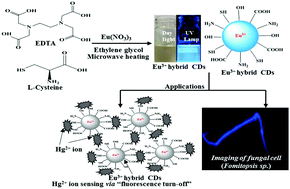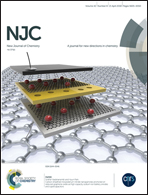Microwave-assisted synthesis of water-soluble Eu3+ hybrid carbon dots with enhanced fluorescence for the sensing of Hg2+ ions and imaging of fungal cells†
Abstract
In this work, a fluorescent nanosensor based on Eu3+ hybrid carbon dots (Eu3+-CDs) was fabricated by single-step microwave heating using ethylenediaminetetraacetic acid (EDTA), L-cysteine and europium(III) nitrate as reagents. The as-synthesized Eu3+ hybrid CDs exhibited a characteristic fluorescence emission peak at 427 nm upon excitation at a wavelength of 343 nm. Upon the addition of Hg2+ ions, the emission peak of the Eu3+ hybrid CDs was quenched and a linear relationship was observed between the fluorescence quenching intensity and the concentration of Hg2+ ions in the range of 5.0–250 μM with a detection limit of 2.2 μM. The developed nanosensor not only enables selective and sensitive detection of Hg2+ ions but also offers excellent applications in the confocal imaging of fungal cells (Fomitopsis sp.), which holds great promise in biomedical applications.



 Please wait while we load your content...
Please wait while we load your content...